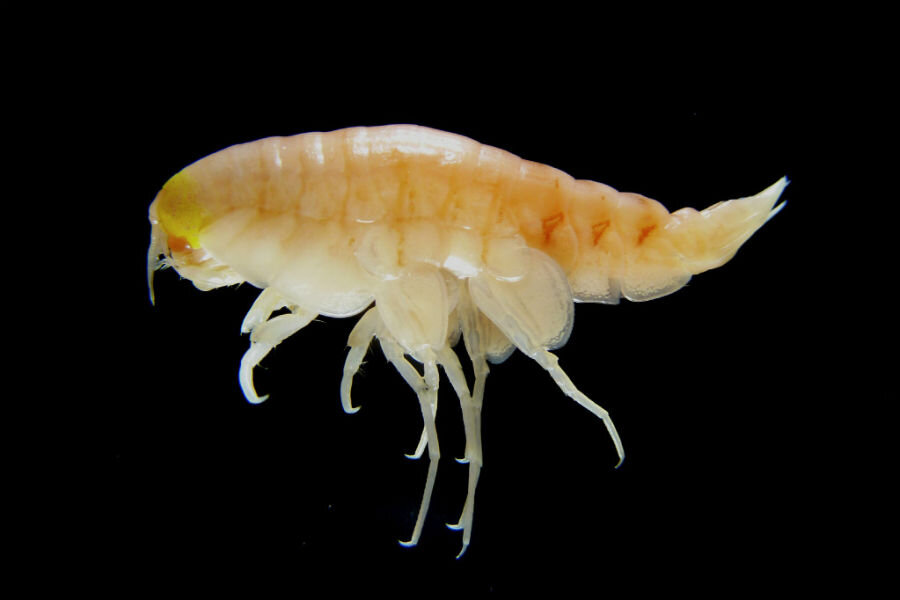How did banned chemicals wind up in the deepest trenches of the ocean?
Loading...
A new study has found that certain harmful chemicals banned since the 1970s are still turning up in ocean critters today, almost 40 years later.
But the presence of pollutants in animals living in some of the deepest trenches of the sea only scratches the surface of the problem, according to Thomas Arnold, a biochemist and biology professor at Dickinson College who was not involved in the study.
"The high levels of these chemicals in the deepest reaches of the ocean is unexpected, but their presence there should not be surprising to us given the size of the human population and the vast amounts of industrial products we produce. It is increasingly clear that there is no pristine place on Earth not touched by human activity," he tells The Christian Science Monitor via email.
The study, published in the journal Nature Ecology and Evolution, catalogs the presence of persistent organic pollutants (POPs) in the fatty tissues of multiple species of small, shrimp-like creatures called amphipods, which live in some of the deepest waters on Earth. The samples for the study were collected by deep-sea landers from Kermadec and Mariana trenches in the Pacific Ocean, which are both more than 10 kilometers (about 6 miles) deep.
The team of British researchers found that levels of the contaminants of polychlorinated biphenyls (PCBs) and polybrominated diphenyl ethers (PBDEs) were unexpectedly high, even at depths up to 10,250 meters. Both chemicals, associated with various health risks, were commonly used for much of the 20th century until they were eventually outlawed. PCBs were banned by the United States in 1979. Later, they were banned internationally by the Stockholm Convention on Persistent Organic Pollutants, a UN treaty signed in 2001, and PBDEs were added to the list of substances banned by the convention in 2009.
Though no longer permitted to be used in production, the sheer volume of these chemicals used prior to their prohibition, coupled with their persistence in the environment, has made it extremely difficult to eradicate them from ecosystems.
Between 1930 and the end of PCB production in the 1970s, the total global production of POPs was about 1.3 million tons. The chemicals, which were used as flame retardants and in plastic products, respectively, are highly resistant to being broken down through natural processes. About 35 percent of these chemicals are thought to have leaked into coastal sediments or open oceans in the decades since.
"The amphipods we sampled contained levels of contamination similar to that found in Suruga Bay, one of the most polluted industrial zones of the northwest Pacific," said study lead author Alan Jamieson in a statement. "What we don't yet know is what this means for the wider ecosystem and understanding that will be the next major challenge."
The problem is the difficulty and cost associated with viewing deep-sea environments, says Paul Snelgrove, network director of NSERC Canadian Healthy Oceans Network. Conducting scientific studies underwater with almost no light, extremely high pressures, and many unknown variables make it difficult to say what the ultimate affect of the POPs might have the ecosystem. However, Dr. Snelgrove tells the Monitor in an email that deep-sea creatures tend to live longer than their surface relatives due to their adaptations to their "relatively unvarying environment," which likely will leave them "vulnerable" to such contaminants.
Many animals that live near the bottom of the sea rely on material sinking down from the surface for food, since there is not enough light to power photosynthesis in deep-sea trenches. This can lead to the unfortunate domino effect of bioaccumulation, wherein animals that have consumed contaminated debris are then eaten by other animals, which then become contaminated themselves, and so on.
"Ocean waters can take decades or centuries to 'turn over' but eventually they are exposed to many of the same pollutants that occur on land," says Dr. Arnold. "These particular pollutants (PCBs) accumulate in organisms and remain in their tissues because of their chemical nature. They can move up the food chain, and they are long-lasting in the environment."
Cleaning the plastic and other pollutants out of the oceans has been a goal of environmentalists for decades, but most of these efforts are geared toward skimming trash off the surface of the ocean rather than removing harmful substances from super-deep areas like the Marianas trench.
"Some chemists suggest there are specific binding agents that can selectively take dangerous materials out of circulation," Jeremy Montague, professor of Marine Biology at Barry University in Miami, tells the Monitor in an email. "However, without close monitoring and assessment methods, it is difficult to see how such binding agents will work effectively in the deep sea. It is an environment of surprises and disappointments for researchers."
For now, preventing further contamination will be the key to minimizing the problem as much as possible, as scientists continue to explore new possibilities for repairing the damage that has already been done.
"This research shows that far from being remote the deep ocean is highly connected to the surface waters," said Dr. Jamieson. "We're very good at taking an 'out of sight out of mind' approach when it comes to the deep ocean but we can't afford to be complacent."
This article contains material from Reuters.








